Exchanging gifts is a tradition of Americans to celebrate Christmas with their beloved ones. According to GiftNow, an average shopper spends $65 per gift and purchases around 8 gifts for the Christmas season. However, choosing a gift requires some thoughts to fit with the receivers, as unwanted gifts are a waste, especially amid inflation in 2022.
The latest holiday consumer report by Deloitte reveals that 38% of U.S. customers are likely to start shopping earlier this year. It also discloses that 23% of the holiday budget will be spent at the end of October, compared to 18% in 2021. Americans are buying Christmas gifts earlier to stretch out their budgets and reduce the stress of holiday shopping. Therefore, retailers should be prepared to meet this pattern by earlier stocking or applying new sales and promotion tactics.
In this article, we will cover the overview of Christmas shopping in the U.S., the list of unwanted gifts, and actionable insights for retailers in a year of upheaval like 2022.
- Current shopping situation in the U.S
- Popular Christmas gifts in 2022
- How inflation affects Christmas shopping
- Least wanted Christmas gifts in 2022
- Common reasons behind the unwanted presents
- What do Americans do with their unwanted gifts?
- Who is the most disappointing giver?
- Do Americans actually address the “unwanted” part?
- 4 tips for shoppers this Christmas
- 8 tips for retailers to prepare for this Christmas shopping
Current shopping situation in the U.S

The most noticeable customer behavior is their intuitive shopping activities across channels. Omni-customers are now searching for products both online and offline, with a variety of formats like websites, apps, social media, physical stores, or pickup methods. Retailers now have more touchpoints to reach and engage with customers. A proper solution to recognize customers and offer a seamless experience across channels is the key to leveraging omnichannel sales.
According to Inmar Intelligence, 42% of customers will shop equally online and in-store for holidays. Although customers have discovered the convenience of online shopping after 2 years of the Covid-19 pandemic, they’re also returning to traditional brick-and-mortar stores. They’re getting out of their homes again and expect more from brands to offer an omnichannel shopping experience.
In the same holiday retail survey, Deloitte found a similar trend for omnichannel opportunities:
- Online shopping takes a 63% share in 2022, remaining quite steady with the last 2 years;
- After in-store shopping reached its bottom in 2020 with 28% share, it rebounded and grew to 35% in 2022;
- Online retailers (56%) and mass merchants (49%) maintain the position as the favorite holiday retail formats, although slightly decreasing since 2019 (60% and 52% respectively).
- Usage of social media for holiday shopping has a swift increase from 28% in 2021 to 34% in 2022.
Another report from GiftNow about the shopping season highlights the dominance of online shopping to malls and open-air shopping centers (excluding standalone retail stores):
- Online search is the best choice among all channels for both searching and purchasing gifts. 82% of shoppers are “likely” or “highly likely” to use search engines for gift inspiration. For making purchases, 74% cited the same likelihood to buy gifts using online search;
- The second favorite channel is brand or retailer websites. Holiday customers report they are at least “likely” to seek inspiration (72%) and purchase gifts (71%) via this channel.
For retailers, that means you have to prepare for both online and offline stores to offer a unified omnichannel experience for tech-savvy shoppers. Be prepared to handle larger traffic during holiday shopping. Make sure your website is running fast and displays correct product information, while your in-store has a good layout that showcases products in a smooth walk path. You should also optimize the checkout counter to boost sales and provide quick delivery service for customers.
Before all that, let’s start with forecasting the demand for different types of gifts to avoid overstocking or understocking.
Popular Christmas gifts in 2022

The research from Inmar Intelligence released that gift cards, gaming or entertainment products, apparel and jewelry are the most popular choice of gift, with 48%, 44%, and 39% of respondents citing respectively. When asked what they want to receive, 48% of people still stick to gift cards as their favorite present, and cash is the second option (46%). The list continues with some equally liked items: apparel or jewelry (32%), entertainment products (31%), and home appliances and electronics (30%).
What people give and want to receive aren’t necessarily the same. While 36% of the participants give personalized products, only 25% of them like this type of gift. On the other hand, cash is only given by 24% of the respondents, but there are significantly 22% more people wanting to receive it.
In GiftNow’s survey, some participants think that gift cards are impersonal. When asked about the key factors to make gift cards more personal, customization stays on top:
The appearance of a gift card is among the top 3 factors to personalize this gift category, with 64% of respondents citing so. In particular, 39% agreed it is the topmost factor, by far the largest proportion.
The second-ranking factor is the ability to customize the packaging of gift cards, cited as one of the top 3 by 43% of respondents.
How inflation affects Christmas shopping

2022 has witnessed many economic challenges. Inflation is the top concern in shoppers’ minds this holiday. In a report by KPMG, 87% of surveyed consumers admit they are moderately or extremely worried about inflation.
In particular, the U.S. Bureau of Labor Statistics reported that consumer prices in September 2022 rose 8.2% from the last year. The figure is near the highest inflation level since the early 1980s, causing a sharp decrease in the purchasing power of average Americans. According to Moody’s Analytics, customers now have to pay $445 more each month to buy the same amount of goods and services as they did a year ago.
With prices going up for all products, U.S. customers have to recalculate their budget for gifts and whom they will buy gifts for. According to Salesforce, 51% of Americans intend to buy fewer gifts this year than in 2021, with the main focus on their family and close friends. Moreover, shoppers plan to purchase 8 gifts this holiday season, down 11% from 9 gifts last year, as reported by GiftNow. However, spending expectations increased 7% to $580 on average, implying customers have to spend more on a per-gift basis: $65 this year versus $60 in 2021.
Amid the intense inflation, Americans will opt for less-expensive gift categories, and shift their spending to budget-friendly stores. 58% of holiday shoppers claim that sales and promotions are important factors in making purchase decisions for gifts, as revealed by NRF and Prosper Insights & Analytics. Compared to last year, the number was only 46%, indicating that customers have become significantly more price-sensitive this year.
Retailers must adapt to the current situation by modifying their marketing calendars and promotion strategies to meet consumer demand. A useful approach can be launching holiday sales early or offering financing options like buy now pay later to support customers amid inflation and higher cost of living.
Besides, retailers should focus on selling the products that gift receivers love, such as gaming products, apparel or jewelry, and electronics. These categories will see a higher demand for Christmas, which need proper inventory replenishment and marketing activities to increase revenue.
In contrast, let’s take a look at the presents that Americans like least.
Least wanted Christmas gifts in 2022
In early October 2022, Magestore surveyed 1,122 American shoppers to find out what are the most disliked gifts for Christmas. Top of the list is flowers and plants (42%), followed by beauty products (40%), and liquor or drinks (34%). To be on the safe side when choosing gifts, you can go for electronics and tech gear – as only 8.47% of the respondents said it was their least favorite.
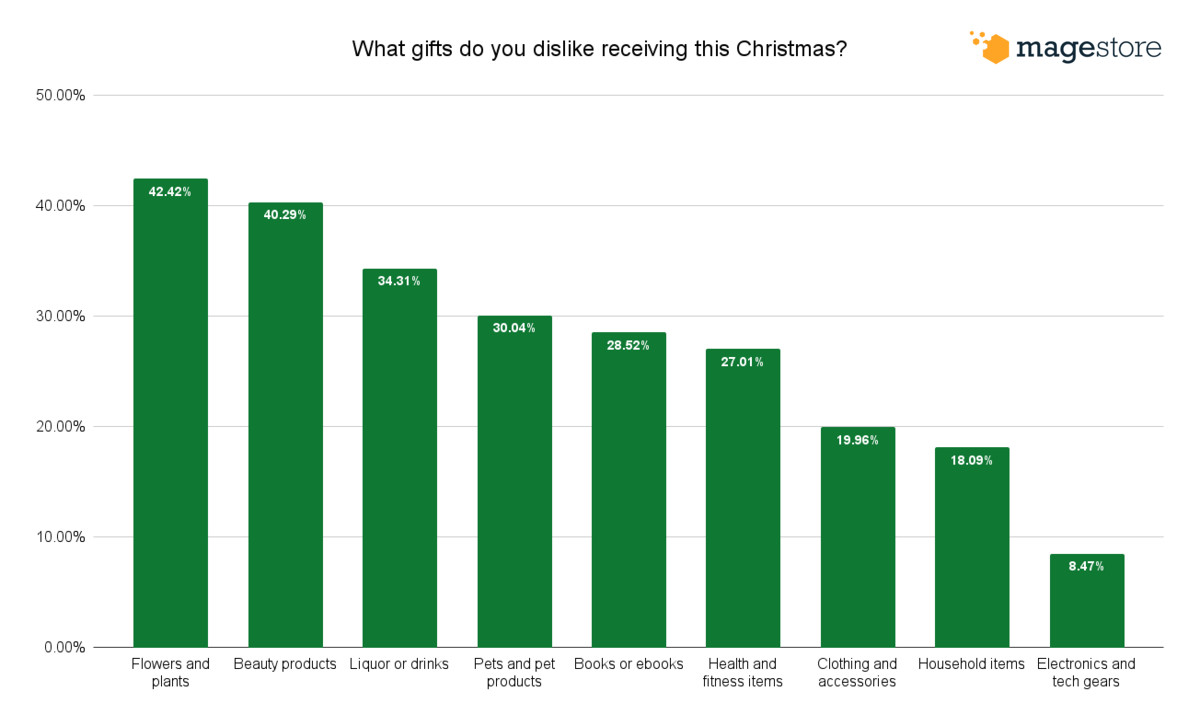
Unwanted gifts by gender
Men and women have different tastes in what they dislike most. The list of men’s least wanted gifts is beauty products (51.80%), flowers and plants (48.77%), and books and ebooks (31.38%). For women, liquor or drinks are listed as the most unwanted presents (40.64%), next are flowers and plants (36.76%), and health and fitness products come after (31.70%).
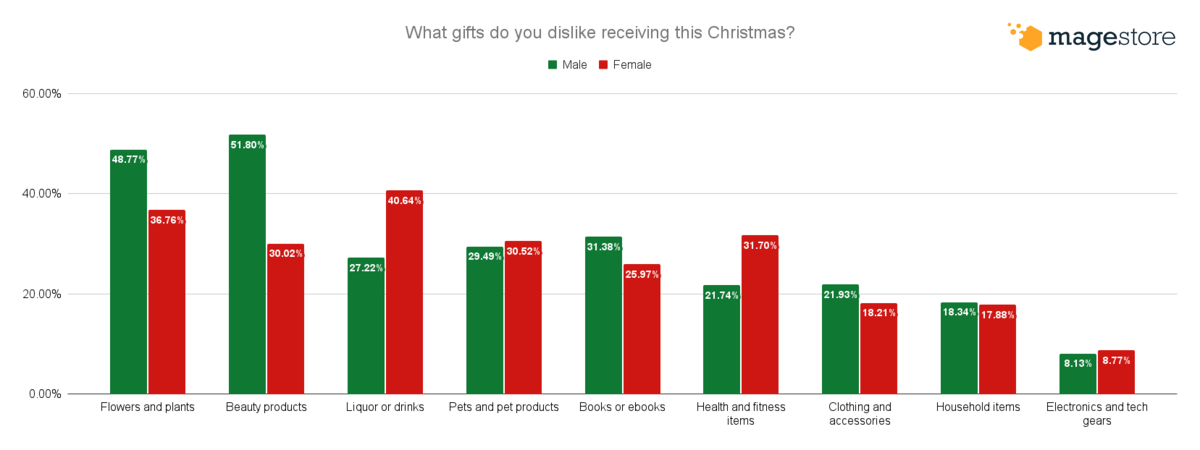
Unwanted gifts by age
A majority of Gen Z isn’t in favor of flowers and plants (40.08%), beauty products (33.07%), and books (33.46%). For Gen X and Millennials, the top 3 unwanted gifts are the same: flowers, beauty products, and drinks. On the other hand, Boomers say that they least like beauty products (42.57%), liquor (40.59%), and health and fitness items (39.60%).
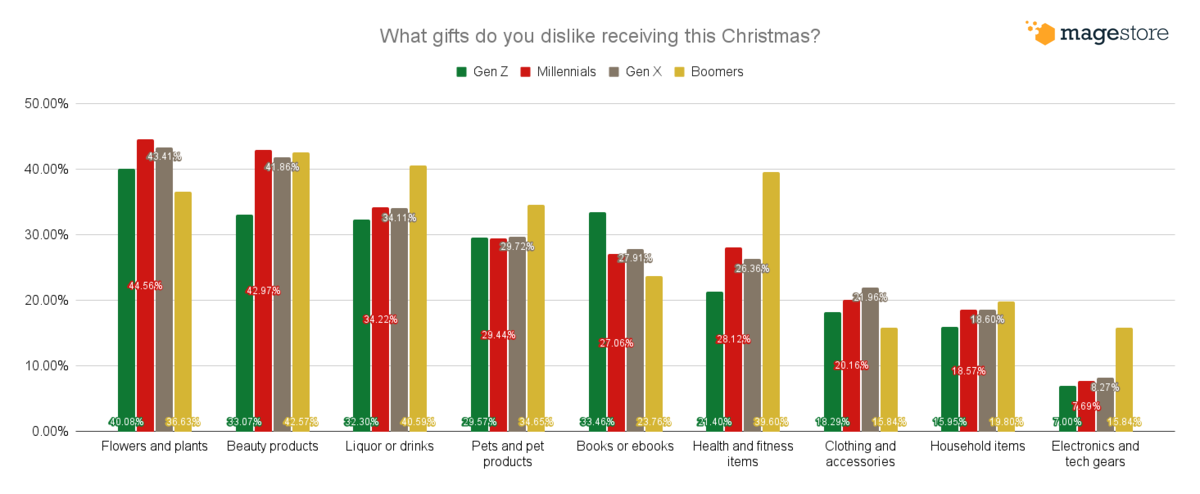
Common reasons behind the unwanted presents
Over half of the participants (52.41%) don’t want a gift that is useless for them, and 50.27% don’t like a gift that doesn’t fit their interests.
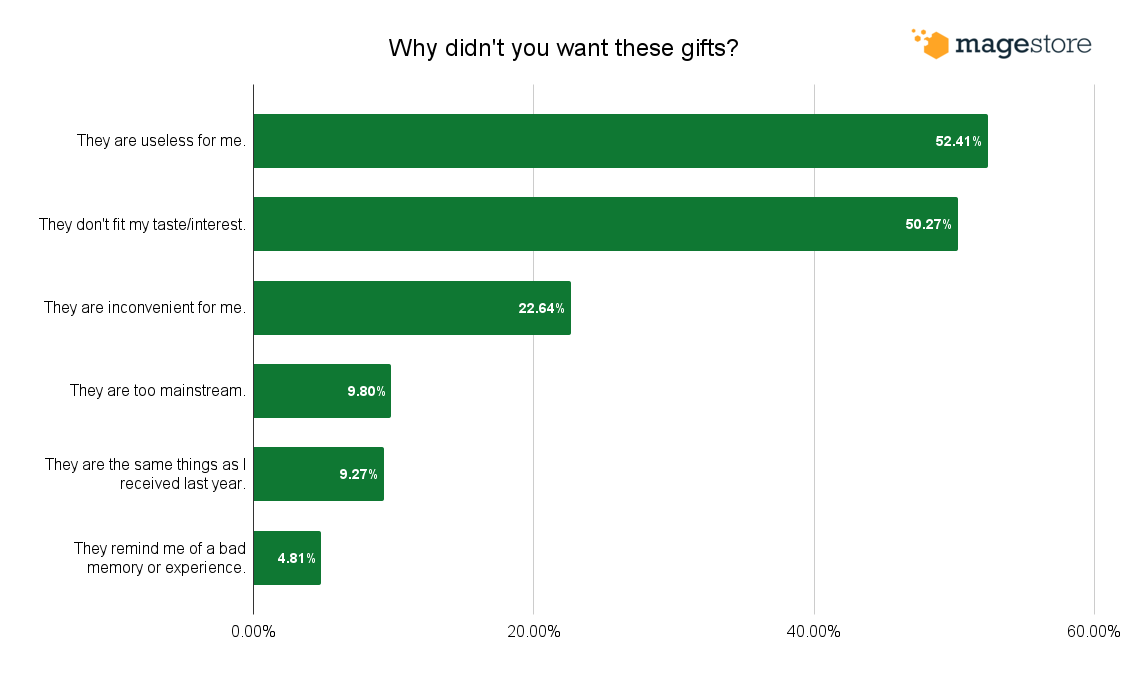
Looking at the reasons together with the top 3 wanted gifts, we can see that Americans require more personalized products.
Plants and flowers are the worst gifts since Americans usually buy and decorate their own Christmas trees for the holiday. Giving them another tree will just make their house more cluttered.
Giving beauty products isn’t a good idea unless you know what products the receiver is using. People tend to stay with products that work for them. In addition, cosmetics items have expiry dates, so this type of gift should only be bought when they’re running out of.
Liquor and drinks, though depending on personal taste, are likely to be cut down on spending this year. Non-essential and expensive products like alcohol will take a backseat this year due to inflation.
Reason for unwanted gifts by gender
Asking men and women why they don’t want these gifts, the most common reason for women is that these gifts don’t fit their taste (51.26%), while 57.66% of men explain that these items are useless for them.
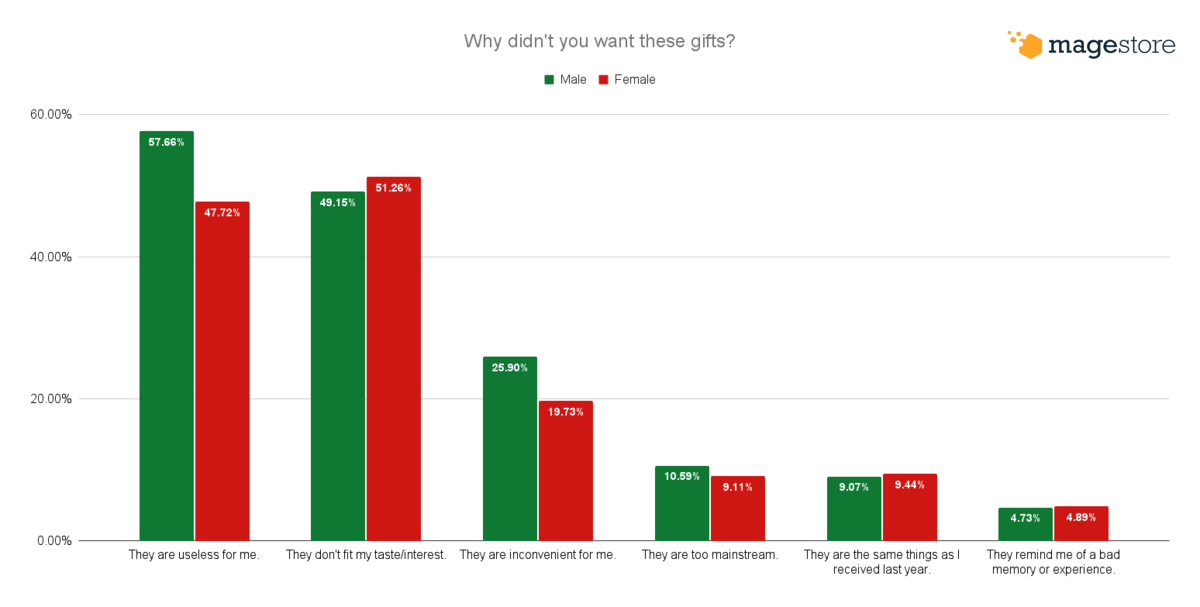
Reason for unwanted gifts by age
Gen Z and Millenials favor practical gifts, as around 55% respond that they don’t want to receive useless items. For Gen X surveyees, unfit gifts with their interests is the most popular reason (50%).
Practicality is a key point of consideration for Gen Z and Millennials, with 55% stating that they don’t want useless items as gifts. On the other hand, 50% of Gen X participants say they don’t want gifts that don’t fit their taste.
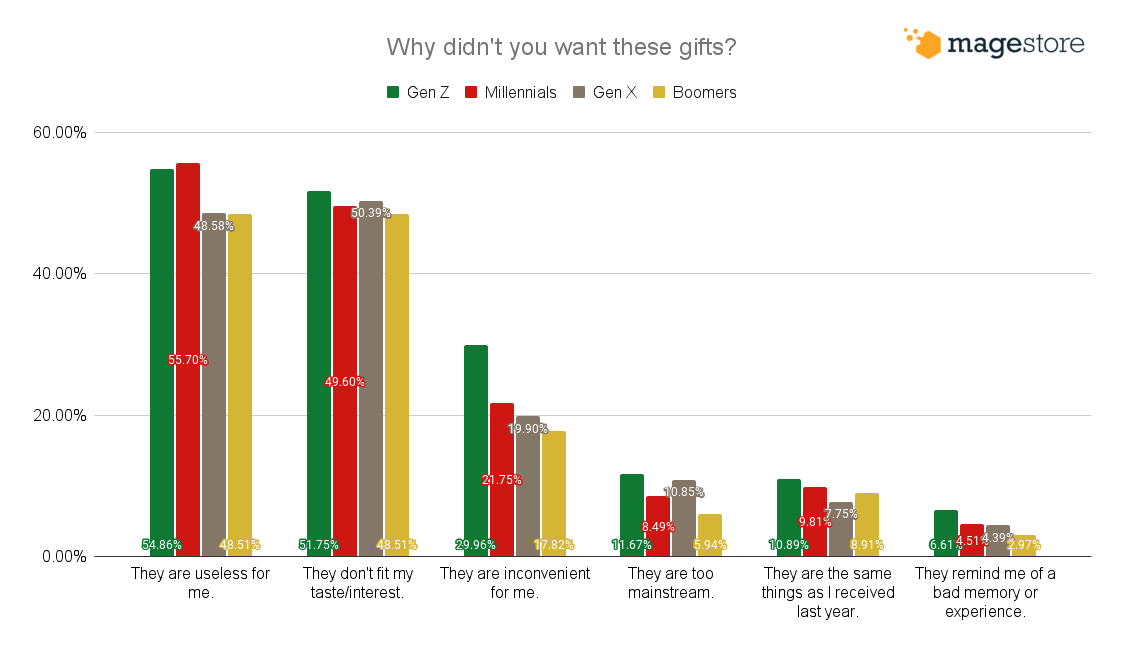
What do Americans do with their unwanted gifts?
It is a common practice for Americans to regift or donate their unwanted gifts (56.60%). The next option is to return or exchange the gift for another product they like (42.34%), which means retailers should be prepared to handle product returns and exchanges.
29.77% of participants will keep the gifts, while 13.55% plan to resell them. The last method is to throw the gifts away (9.63%).
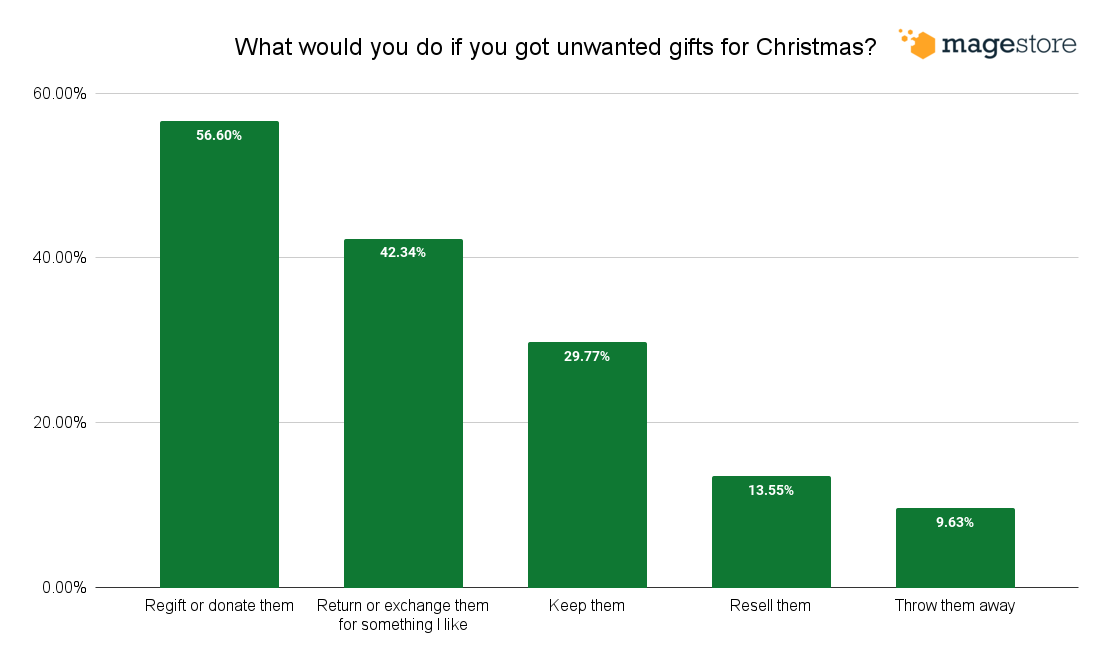
What men and women deal with unwanted gifts
Over 60,54% of women would regift or donate unwanted presents, as compared with 52.17% of men. In contrast, men are 2 times more likely to throw the gift away than women (13.04% and 6.58% respectively).
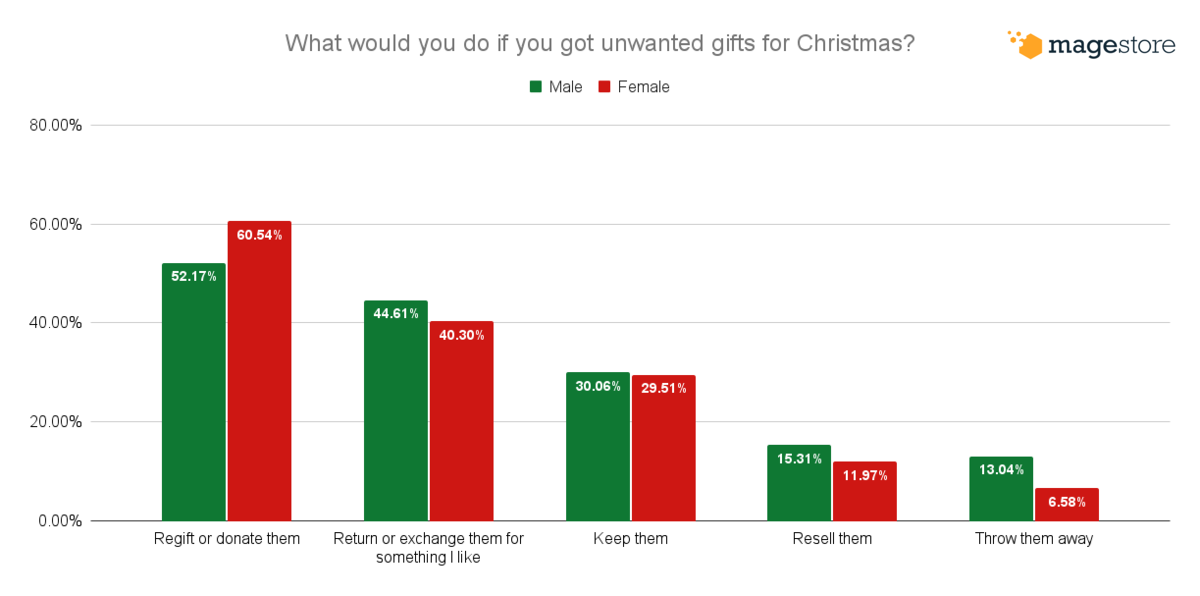
What each generation does with unwanted gifts
When asked if they would keep unwanted gifts, Gen Z is the most likely to do so (35.02%), while Boomers are the least likely (20.79%). Millennials have the highest tendency to throw away unwanted gifts (12.47%), while Gen X will most likely regift and donate them (57.88%).
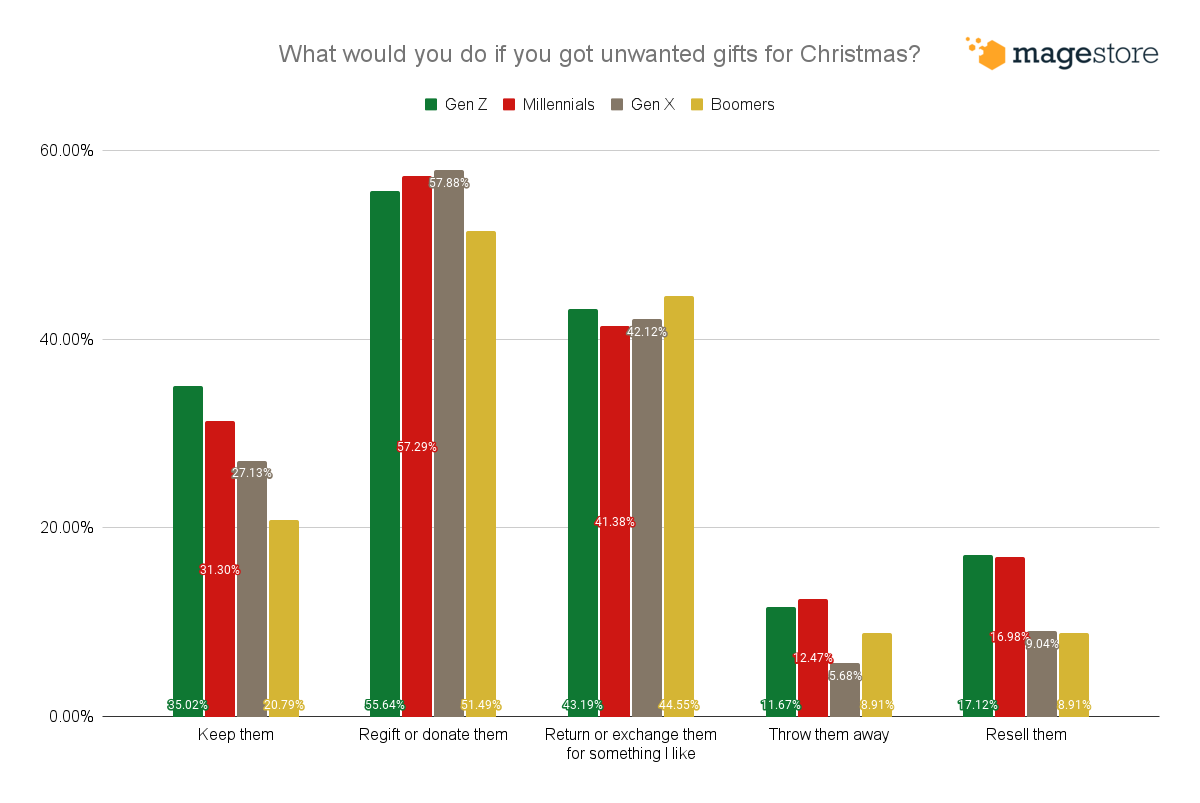
Who is the most disappointing giver?
The most common answer is their partner, agreed by 43.14% of the survey participants, far exceeding the other opinions.
Parents and best friends come as the second (16.67%) and third (14.71%) worst givers. Boss and colleagues are considered the most disappointing giver by 11.50% of respondents, and less than 10% will be most disappointed when receiving disliked gifts from siblings or their children.
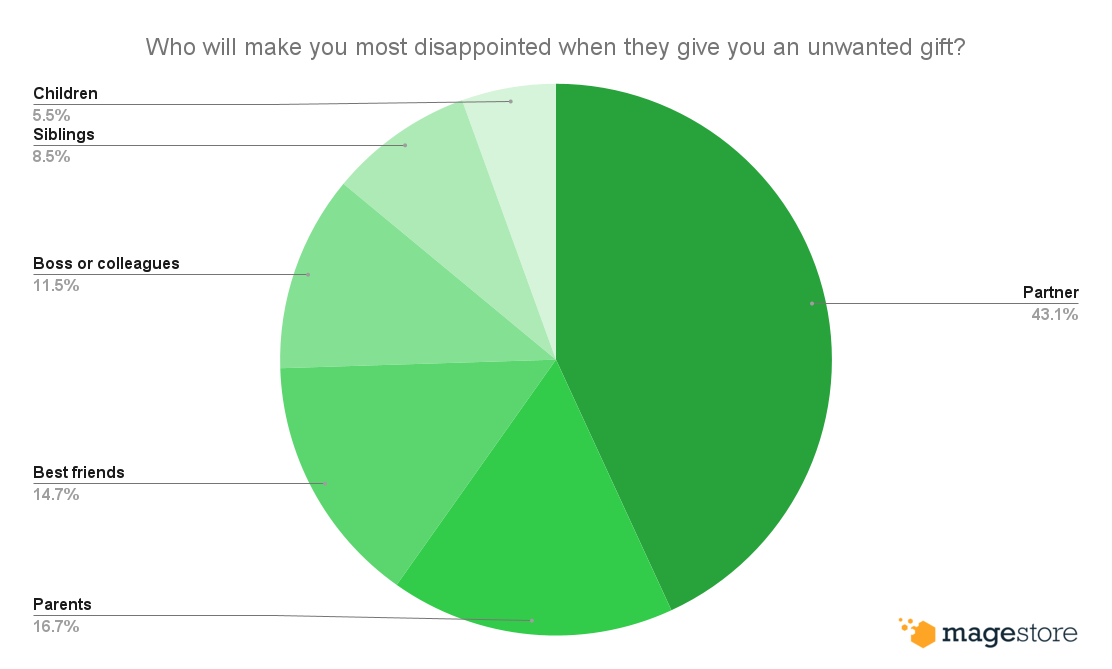
There are many reasons that you may choose the wrong gifts for your family, friends, and colleagues, such as:
- Too busy to search for a suitable gift,
- Buy discounted items that don’t meet the receiver’s taste,
- Buy the products you like but the receiver may not like.
To help shoppers decide on the right gifts, retailers can organize products into gift categories, such as gifts for dad, for children, for her, for boss, etc. Retailers can also suggest hot items and provide suitable deals for favorite products. In addition, sales reps should talk to customers to understand their expectations and insights to recommend the best gift ideas.
Most disappointing givers by gender
Both genders agree that their partners would make them most disappointed by unwanted gifts. In detail, there are more women (46.37%) who are upset than men (39.51%). On the other hand, men are pickier about gifts from their boss and colleagues, with 13.99% of men claiming workmates as the worst givers, as opposed to 9.27% of women.
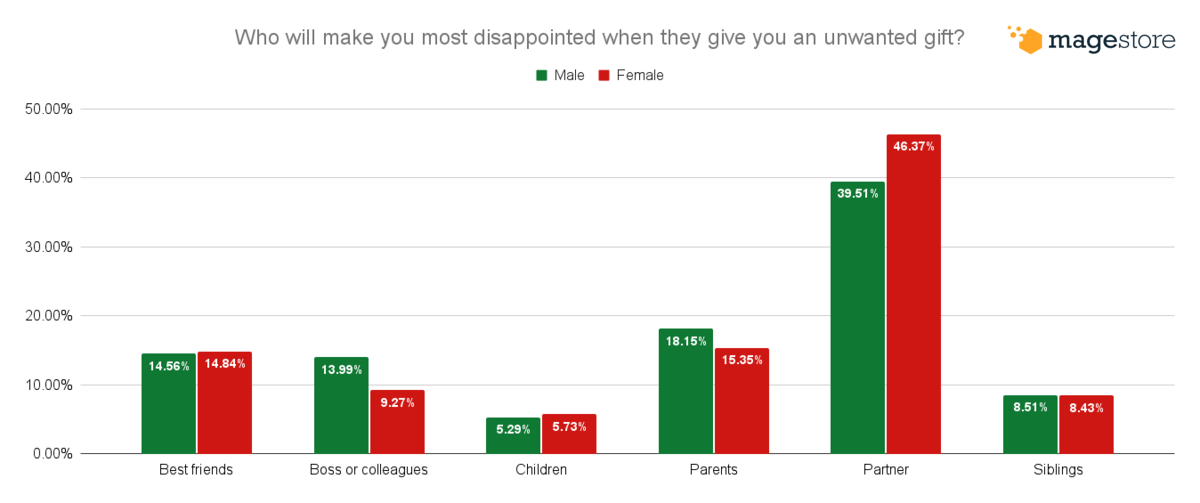
Most disappointing givers by age
The same result applies across all generations: Partner is the worst giver. The second most popular choice is usually their family. One-fourth of Gen Z (24.51%) and one-fifth of Millennials (19.10%) say that unwanted gifts from parents will disappoint them most.
13.70% of Gen X participants choose their boss or colleagues as the most disappointing givers, while for Boomers, it is their children (14.85%).
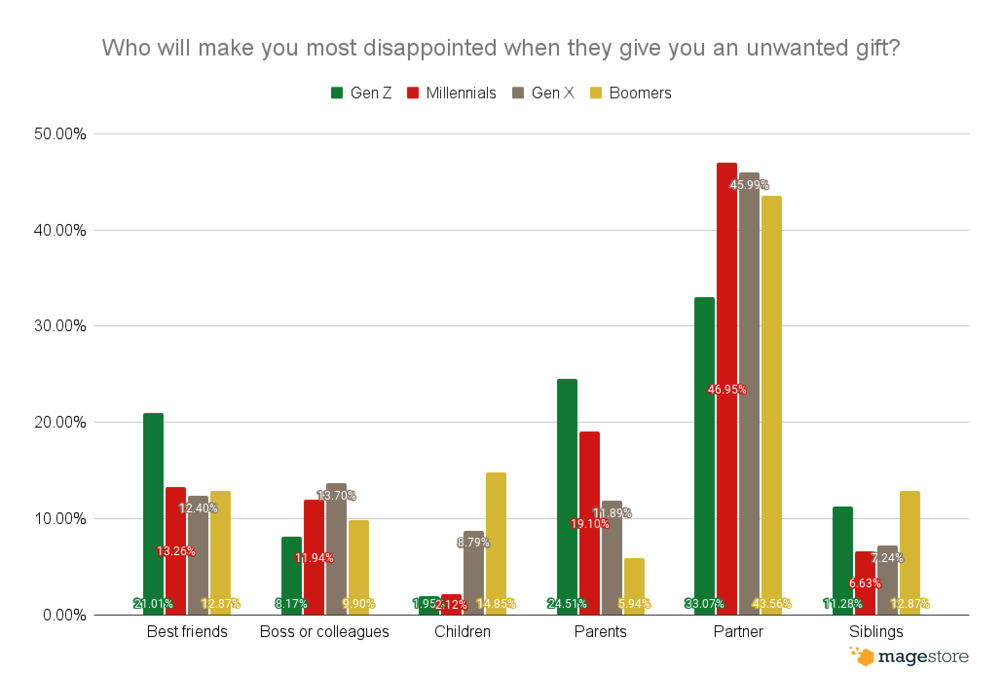
Do Americans actually address the “unwanted” part?
When asked if they would request the person stop giving unwanted gifts next year, only 27.72% of respondents express a firm yes. 42.25% say they may speak about the unwanted gifts, while 30.04% will say nothing.
As a common pattern for both genders, over 70% of respondents don’t or mayn’t tell the giver to stop, although more women (52.85%) have received a gift they did not like than men (47.15%).
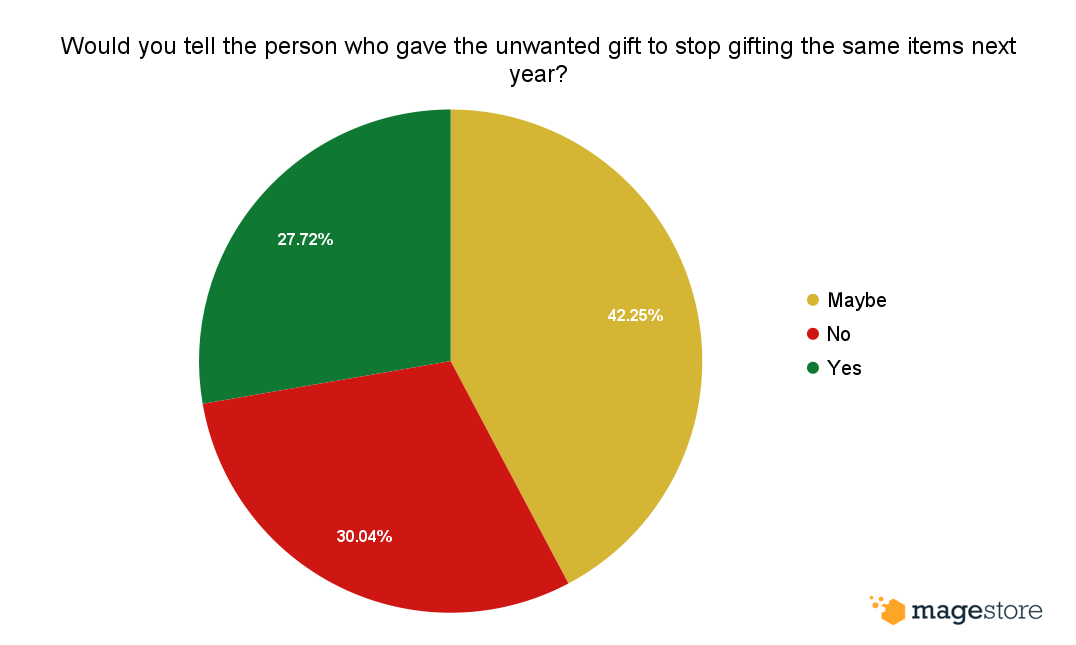
4 tips for shoppers this Christmas

As the inflation rate in 2022 is the highest since August 1982, demand for practical and personalized gifts will be the main focus this Christmas. To help you choose meaningful gifts for your beloved ones, here are the 4 tips:
Consider who you’re buying for
You need to pay attention to who you’re buying for. Think about their interests, hobbies, personality, or likes and dislikes to choose a personal and thoughtful present. Even better, you can look for customizable products that are tailored to the receiver.
Consider what they’ve been up to lately
Let’s be practical. The gift should be useful for the recipient, such as an upgrade from something functional or a product that helps them solve their problems. For example, if you know a friend about to move into a new home, some house applications can be a good idea for Christmas and house-warming gifts.
Ask the receiver for their wishlist and what gift they want
To avoid giving unwanted gifts, you can simply ask your family members and friends for their wishlists. Sharing wishlists is an easy way for people to understand each other’s preferences and exchange the right gifts.
Shop for gifts early
Starting your shopping early will give you more time to browse and more options to choose from. You can ask sales reps to give you a consultation to find the perfect gift and check their availability.
Although supply chain disruption isn’t as severe as in 2021, it’s best to make sure the products you plan to buy are available and can be delivered before Christmas. If possible, you can use the click-and-collect option to order gifts early and collect them later in-store.
8 tips for retailers to prepare for this Christmas shopping

- Optimize your website and POS checkout. Make sure you can handle a larger amount of traffic and have enough sales staff to help customers.
- Offer click and collect options to alleviate the stress on logistics. During this busiest shopping season of the year, you should drive customers to order in advance so you can plan on-time logistics activities.
- Forecast customer demand to stock up enough inventory, focus more on the most wanted gifts and less on the unwanted. Also, think about how you will deal with stockouts and shipping delays.
- Simplify shopping experience and create a seamless O2O connection. Make it easy for customers to find products, get support, and check out on any channel.
- Prepare for the return and exchange process, including a clear policy and proper system. Customers should be able to return products across channels and stores for their convenience. Offering an easy experience for return and exchange can make customers happy with your brand and create a sale opportunity for another item.
- Advise consumers on the gifts that they should not buy for their partners, family members, or friends. Now you know the least liked gifts based on gender and generation, you can share this information with your customers to help them avoid picking up unwanted presents.
- Launch your marketing campaigns and promotions early to match customers’ tendency to early shopping. Make sure you reach out to them as soon as possible before they finish their shopping at your competitors.
- Prepare a list of actions and solutions for common holiday issues, such as substitutions for out-of-stock items or preprinted RMA forms. Anticipating will make you more proactive in preventing and dealing with these situations.
Conclusion
2022 is a year like no other with intense inflation, supply shortages, and changes in customer behaviors. Retailers, hence, need to adapt and have a suitable strategy for this Christmas shopping season. We hope our summary and findings on the most wanted and unwanted gifts can give you valuable insights and ideas to reach customers with the right products, at the right time, and at the right channel.














